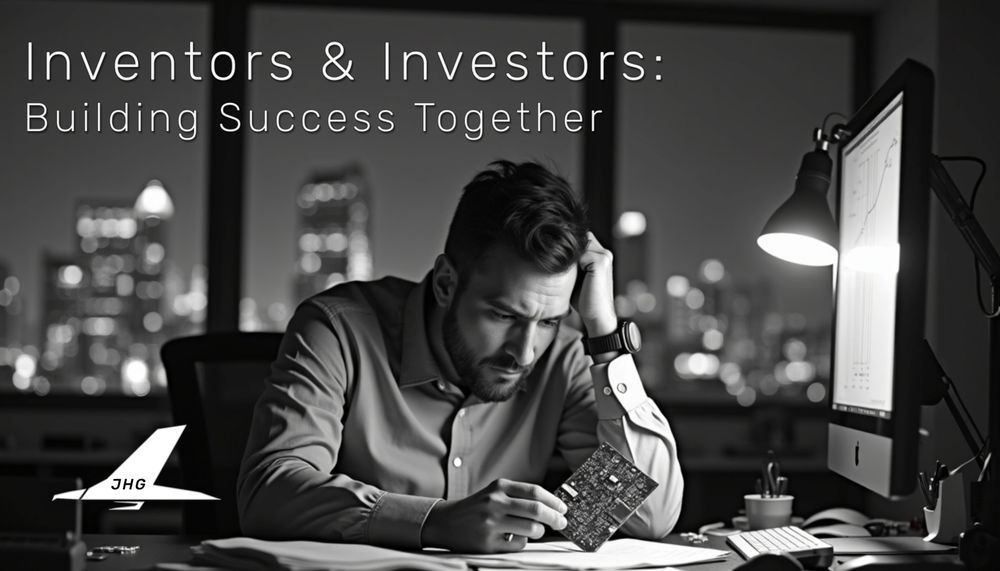Bridging the Gap: How Inventors Can Successfully Work with Investors and Build Thriving Startups
By Matthew Johnson 2025-04-16
Inventions represent brilliant solutions to complex problems, but transforming a great invention into a successful business requires much more than technical ingenuity. Many inventors struggle to secure funding and build sustainable companies, often due to fundamental disconnects between how inventors and investors approach business. This comprehensive guide explores why inventor-led startups frequently fail, what investors actually look for, and how inventors can overcome these challenges to build fundable, successful companies.
Understanding the Inventor-Investor Divide
Inventors and investors often inhabit different worlds with conflicting priorities and perspectives. While inventors focus on creating revolutionary products, investors seek businesses with clear paths to market dominance and financial returns. This fundamental disconnect leads to frustration on both sides.
Why Most Startups by Inventors Fail
Too Product-Focused, Not Market-Focused
Inventors frequently fall in love with their creations without first confirming market demand. As Aaron Ohanian explains in his interview with inventRightTV, inventors need to "remove emotions from the process" and approach their inventions logically^6. Common pitfalls include optimizing for features rather than addressing customer pain points and building products "because they can" instead of solving urgent market problems^2.
Even the most elegant invention holds little value without clear market pull or an adoption strategy. According to venture capitalist research, investors evaluate market opportunities as a primary consideration when deciding whether to invest^3. This means inventors must demonstrate not just that their product works, but that customers are actively seeking the solution.
Lack of Business and Go-To-Market Skills
While inventors excel at creating solutions, startups require expertise in marketing, sales, hiring, fundraising, and distribution. Many inventors lack experience in these critical business areas^2. Without these skills, inventors often burn through capital refining technology rather than acquiring customers.
According to David Chang, an angel investor and entrepreneur, "First-time entrepreneurs often put too much value on the idea or concept itself — but ideas are worthless without execution and a business structure that de-risks the venture at each stage of growth"^8. This perspective highlights why investors prioritize execution capabilities over inventive brilliance alone.
Over-Engineering and Perfectionism
A common inventor tendency is continually improving a product rather than launching a minimum viable version to gather feedback^2. This perfectionism leads to extended development cycles without market validation. By the time such products launch, competitors may have already captured the market or customer needs may have evolved.
Inventor Aaron Ohanian addresses this challenge directly, noting that many inventors get caught in endless refinement cycles rather than testing market viability^6. This perfectionism often stems from emotional attachment to the invention.
Difficulty Pivoting Based on Feedback
Many inventors struggle to adjust their vision when market feedback suggests a different direction^2. This inflexibility can doom otherwise promising ventures. Investors recognize that most successful startups pivot significantly from their original concept, making adaptability a crucial trait.
Research conducted by Wilbur Labs found that about 70% of entrepreneurs face potential business failure, with nearly 66% encountering this possibility within 25 months of launching^4. This statistic underscores the importance of adaptation in entrepreneurial success.
Poor Storytelling and Communication
Technical creators often struggle to explain their inventions in simple, human terms that resonate with investors and customers^2. Investors need clarity, emotion, and a compelling story—not technical specifications or patent details. This communication gap frequently prevents otherwise promising inventions from securing funding.
What Investors Actually Look For
Team Composition and Balance
Investors consistently prioritize balanced founding teams over solo inventors. The ideal startup combines complementary skills, often described as the "Hacker, Hipster, and Hustler" trinity^5:
- Hacker: The technical expert who builds the product
- Hipster: The design-focused team member who ensures exceptional user experience
- Hustler: The business-minded founder who handles sales, fundraising, and operations
This balanced approach addresses investors' concerns about team completeness. As noted in advice from angel investors, "Investors bet on teams, not individuals"^8. A solo inventor without strong business partners often appears as an incomplete investment opportunity.
Market Validation and Customer Demand
Before approaching investors, inventors must demonstrate genuine market demand. Venture capitalists evaluate "market investment opportunities" and "competitive edge" when considering funding decisions^3. This requires inventors to move beyond theoretical applications and showcase real customer interest.
Chang advises that entrepreneurs should "explore an idea, and with the low cost of capital to start a company today, it's super easy to put something together and begin to gauge market demand"^8. This market validation significantly improves funding prospects.
Business Model and Scalability
Investors fund businesses, not technologies. Inventors must clearly articulate how their creation will generate revenue, achieve growth, and produce profits^3. According to guidance from the venture capital community, "Not expressing how the business will generate revenue can break the deal. Investors need an understanding of your business model and financial projections to feel confident in your venture's potential"^8.
Execution Strategy and Milestones
A detailed plan for bringing the invention to market reassures investors that founders understand the challenges ahead^3. This includes specific milestones, resource requirements, and timelines. Inventors should demonstrate awareness of potential obstacles and strategies to overcome them.
Realistic Valuations and IP Perspective
Many inventors overvalue their patents or intellectual property relative to execution capabilities^7. While IP provides some protection, investors recognize that successful commercialization depends more on implementation than legal protection. According to expert guidance, "If you are a serial inventor eager to move on to your next big idea, you might consider selling your invention with no strings attached to a third party"^7, indicating that inventors should maintain realistic perspectives on their IP's value.
Building a Fundable Inventor-Led Startup
Creating Balanced Founding Teams
The most successful inventor-led startups pair technical creators with business-focused co-founders. This "Inventor + Hustler" combination balances product development with market strategy^5. As noted by 1337 Ventures, "When a hacker, hipster and hustler come together in harmony, they often turbocharge growth, success and longevity. Plus, it is great for investors too, as a solid founding team weighs heavily when it comes to funding your startup"^5.
Finding complementary co-founders helps address investors' concerns about team imbalance. Stephen Key, co-founder of InventRight, emphasizes the importance of partnerships: "I've always had partners... when one person was a little bit depressed the other one would lift them up... we were able to do more work"^11.
Validating Market Demand Before Deep R\&D
Before investing heavily in development, successful inventors confirm market interest through customer interviews, pre-sales, or low-cost prototypes^3. This approach reduces risk and improves funding prospects by demonstrating market pull.
Angel investor David Chang recommends exploring ideas and gauging market demand before investing significant resources^8. This market-first approach aligns with investor preferences and increases the likelihood of business success.
Developing Emotional Detachment
Psychological research suggests that detachment from work correlates with reduced emotional exhaustion and improved outcomes^10. For inventors, learning to separate their identity from their inventions enables objective decision-making about pivots, feedback, and market strategy.
Stephen Key advises inventors to "protect your creativity" by separating business considerations from creative work: "I work on the business part of it and then when I'm done I'm done I put it aside then I work on the creative side I keep them separate because I know that creative side is what motivates me"^11. This separation helps manage the emotional highs and lows of entrepreneurship.
Learning Business and Go-To-Market Skills
Inventors should actively develop business acumen through education, mentorship, or partnerships^2. Programs like NSF's I-Corps provide "real world training on how to incorporate innovations developed in research labs into commercially viable companies"^9, helping bridge this knowledge gap.
Crafting a Compelling Narrative
Learning to tell your invention's story in terms of problems solved and benefits delivered rather than technical details significantly improves investor and customer communication^3. When pitching to investors, focus on outcomes and vision, not technology specifications.
Funding Options for Inventors
Grants and Government Programs
Multiple grant programs specifically support inventors and early-stage innovation^1^13:
- Small Business Innovation Research (SBIR) and Small Business Technology Transfer (STTR) programs provide up to \$2 million in funding with no equity required^13
- NSF's Convergence Accelerator funds transdisciplinary teams developing societally beneficial technologies^13
- Specialized grants for inventors in specific sectors or regions^1
According to the National Science Foundation, these programs fund "hundreds of deep-tech startups each year working across almost all areas of science and technology"^13.
Angel Investors
Angel investors are typically wealthy individuals who provide early-stage funding in exchange for equity^4. To qualify as an accredited investor, individuals must have earned income of at least \$200,000 for the past two years or a net worth exceeding \$1 million in investable assets^12.
Angel investors often have entrepreneurial backgrounds themselves and look for passionate founders with clear market opportunities^8. David Chang notes that while angel investors may be interested in the founder's story or problem space, entrepreneurs "always need to be able to paint a vision for the opportunity and what the venture could ultimately become"^8.
Venture Capital
Venture capitalists evaluate potential investments based on market opportunity, competitive advantage, management team quality, risk management, and financial projections^3. They typically invest larger amounts than angel investors but expect significant growth potential and returns.
Licensing as an Alternative Path
For inventors who prefer to focus on creating rather than building businesses, licensing offers an alternative to the startup path^7. This approach allows inventors to partner with established companies that handle manufacturing, marketing, and distribution while providing royalty income.
As noted in expert guidance for inventors, "If you are a serial inventor eager to move on to your next big idea, you might consider selling your invention with no strings attached to a third party"^7. This can be an effective strategy for creators who prefer to focus on invention rather than business building.
Crowdfunding Opportunities
Platforms like Kickstarter and Indiegogo enable inventors to raise funds directly from potential customers^16. This approach provides both capital and market validation. According to funding experts, "Crowdfunding is an excellent option for inventors in the early stages who don't yet have a prototype... A successful crowdfunding campaign requires a strong pitch and a lot of marketing"^16.
Psychological Strategies for Inventor Success
Managing Emotional Attachment
Research on psychological detachment indicates that separating oneself from work during non-work hours reduces emotional exhaustion and improves mental health^10. For inventors, this means developing the ability to view feedback objectively rather than as personal criticism.
Stephen Key recommends consciously separating creative and business activities: "Protect your creativity it's very special that that childlike wonder that allows you to come up with wonderful ideas that's very precious so protect it because there's the business side of it and the business side of it is pretty tough"^11.
Building Resilience Through Community
Finding a supportive community of fellow inventors and entrepreneurs provides emotional sustenance during difficult periods^11. Stephen Key emphasizes this point: "Find your community and you're going to find a group of people that support you through the ups and through the downs"^11.
Creating Financial Stability
Many successful inventors maintain alternative income sources while developing their inventions^11. Stephen Key advises: "Take the financial stress away... if you're counting on royalties or whatever you're doing you're counting on that as an income stream and it's not going to happen yet there's a lot of financial stress"^11. Having financial stability allows inventors to make more objective decisions about their ventures.
Conclusion
The journey from invention to successful business requires more than technical brilliance—it demands market understanding, business acumen, and psychological resilience. By addressing the fundamental disconnects between inventor and investor mindsets, creators can build more fundable, sustainable companies.
The most successful inventors recognize that their creations are means to solving problems, not ends in themselves. They build balanced teams, validate market demand before deep development, and learn to separate their identities from their inventions. By approaching financing strategically and developing business skills, inventors can bridge the gap between technical innovation and commercial success.
The path isn't easy—inventors will face rejection, setbacks, and failures along the way. However, with the right mindset, team, and approach, they can transform brilliant ideas into thriving businesses that attract the investment needed to make a lasting impact.
About Author
Matthew is at the helm of Johnsons Holdings Group (JHG). He provides steadfast leadership defining JHG's strategic approach to nurturing enterprise, startup, and turnaround ventures.
During Matthew’s tenure as Vice President of Product, IoT at HID Global, he spearheaded the creation of cutting-edge SaaS-based IoT platforms, leveraging secure location tracking and AI-driven analytics to provide superior solutions to customers.
With the successful launch of products like HID Bluzone Cloud and HID Location Services, Matthew’s focus on customer relationship management and mobile application innovation significantly enhanced HID’s IoT offerings. As a team, they consistently delivered value-add solutions, cementing their status as leaders in IoT innovation and product strategy.
Matthew has led a cross-functional team of strategists, designers, technologists, and analytics who are considered leaders in business and strategic product development. As a proven leader, he has provided strategic direction by identifying business opportunities, acquisitions, go-to-market strategies, and assessing emerging trends for clients such as HID Global, Coca-Cola, PNC Bank, Verizon, NFL, Sears, AT&T, T-Mobile, Guess, Gap, Motorola Solutions, State Farm, and more.
He founded the Vibes Media professional services and internal agency named “MSG” or Mobile Solutions Group. At Vibes, he grew the practice from an idea with a few people into a full-service mobile agency serving clients such as Verizon, NFL, PGA, Home Depot, Sears, Beam, and Guess. He managed large-scale P&L and led large, award-winning cross-discipline teams (technology, creative, user experience, and project management).
Major accomplishments include:
- January 2024, HID Recognized as a Leader in 2024 Gartner Magic Quadrant™ for Indoor Location Services
- Developing patented & patent-pending security technologies for HID Global
- Founding Bluvision (sold to HID Global in 2016)
- Founding the Mobile Solutions Group at Vibes Media, Chicago IL
- Leading technology on the largest global account at Razorfish, with a retainer in excess of $40M
- Serving as Head of Content Management Center of Excellence at Razorfish from 2009-2011
Matthew has over 25 years of business, consulting, and technology experience. He specializes in C-Suite consulting, omni-channel marketing strategy, mobile technologies, hardware/electronics design, emerging technology, content management, and digital strategy.
Latest
- Bridging the Gap: How Inventors ...
- The AI Talent Race: A Double-Edg...
- Generative Artificial Intelligen...
- Strategic Analysis: Unlocking th...
- Why Generative AI Often Fails to...
- 5 Must-Know AI News Stories from...
- The AI Agent Revolution: What Li...
- The AI Odyssey: What Nvidia’s St...
- Navigating Business Funding and ...
- Riding the AI Waves: The Evolvin...
- The Future of Business: 6 Ways D...
- Generative AI Revolution: The Ne...
- Review: Generative AI’s Act o1 -...
- AI Investment Trends for October...
- Responding to Geoffrey Hinton: D...
- The Evolving Role of the Technol...
- The Future of Business Strategy:...
- Can Venture Capital Weather the ...
- Enterprise Artificial Intelligen...
- Understanding the EU Artificial ...
Tags
© 2024 JHG Consulting | a Johnsons Holdings Group Company | All rights reserved.







